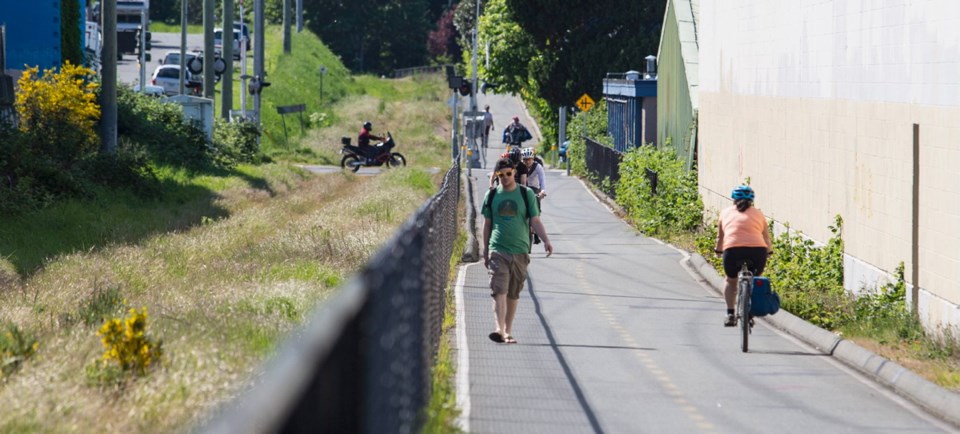The Vancouver Island railway corridor is an amazing asset, which the Island Corridor Foundation has carefully stewarded, but what should we do with it? Restoring the railway does not seem to make financial sense. I understand the romance of railways, but the single-track railway is more than 100 years old, with decayed ties and ancient wooden bridges.
The Ministry of Transportation’s recent Summary Report estimates that it would cost $326 million to restore a diesel-burning train that would run once a day from Courtenay to Victoria leaving at 3 a.m., returning at 5 p.m., and $595 million for a faster train leaving at 5 a.m., plus the operating costs.
We live in Yellow Point, north of Ladysmith, and to take the train to Victoria we’d need to leave home at 5:30 a.m. to find parking in Duncan by 6:30 a.m., arriving in Victoria by 8:30 a.m. A comfortable commuter bus could leave every 15 minutes and get us downtown in an hour and three quarters, including stops. Annualizing the cost over 20 years, restoring the train would require an annual per passenger subsidy of $30,000 to $40,000 a year for the slow train, $44,000 to $65,000 for the faster train.
For most people, the problem is the Malahat, with its occasional crashes when traffic grinds to a halt. Many solutions have been offered, from widening the highway to a bridge to North Saanich or the Highlands, or a route carved through the Sooke Hills Wilderness Park.
Todd Litman is a globally recognized transportation expert who lives in Victoria. He has explored all the options, and in Rethinking Malahat Solutions (April 2020) he concluded that the solution is, quite simply, a bus. Or rather, many buses. Imagining that the train could be a workaround for a blocked Malahat is a non-starter, given that 23,000 vehicles make the trip daily and the train would make the trip just twice a day, once down, once up. Even if you could turn around and get to a station, the train might be full.
Todd’s research shows that a commuter bus from Nanaimo to Victoria that ran every 15 minutes in rush hour and every 20 minutes off-peak could take 10 per cent of the vehicles off the Malahat, reducing the likelihood of crashes and the pressure on downtown parking.
The estimated per passenger subsidy would be $3,800 a year —10 times less than the train for ten times the ease of travel. On what possible planet would taxpayers fork out an additional subsidy of $26,000 to $60,000 per passenger per year, purely for the privilege of enabling people to ride the train and not a comfortable commuter coach?
What then, should we do with the corridor? We should pave it, creating a long-distance multi-use trail that would be great for walkers and cyclists, great for people’s health and sense of adventure, and great for Island tourism, with all its spinoffs. The level route runs through lush forests and farmland, and along the Salish Sea. In Quebec the 5,300 kilometres La Route Verte and similar routes in Europe have been extraordinarily popular, winning support from local businesses.
For the coastal First Nations, a multi-use trail would remove the danger the train used to present to their children, and enable them to generate income through restaurants, galleries and overnight stays, which they could never do when the train rumbled through. The Snaw-Naw-As First Nation, near Nanoose, says it supports replacing rail with a trail.
Such a trail would have another advantage. If the Malahat was blocked, the trail could be used by emergency and utility vehicles. As long as the tracks remain, no other vehicle can use the right-of-way.
Based on the construction of the Okanagan Rail Trail and the government’s new report, creating it might cost $100 million. Annualized over 20 years, shared between the provincial government and the four regional districts at zero interest, it would be $5 million a year, equivalent to 0.66% of the regional districts’ combined annual budgets.
In Victoria, the Galloping Goose is used by an average of 2,000 cyclists and 2,000 pedestrians a day. Estimated ridership for the slow train is 613 passengers a day, 711 for the slightly faster train. For a new 225-km Island trail, it’s hard to guess. Certainly more around populated centres. Victoria to Courtenay would be a comfortable four-day bike trip, or a two-week holiday with cycling side-trips.
Maybe at some future time there could be a monorail above the trail, but for now, restoring the railway would be an extremely costly venture benefiting very few people. Converting it into a multi-use trail, combined with a frequent and affordable commuter bus service, would benefit far more people for far less cost. It’s time to let go the dream of restoring the railway, and turn it into a trail.
Guy Dauncey is a local author and president of the Yellow Point Ecological Society.



